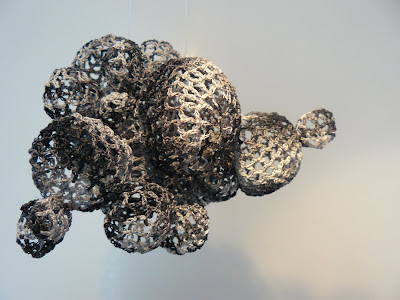Over my years of exhibiting I've learned to understand success along a number of axis including meeting my own exacting standards of quality, receiving attention and positive feedback, expanding networks and enjoying new opportunities, as well as making sales. By savouring and celebrating success in all of these areas I can be pleased with any achievements without being too disappointed by the things I can't control.
If I am able to look around just before people arrive for the opening and feel relaxed pride and enjoyment at seeing my own work, then I consider the exhibition is a success, no matter what else comes to pass. If I want to revisit the show during its season, and am able to look at every work without focusing on imperfections, then I have succeeded in satisfying my harshest critic.
I assess my success at receiving attention by asking whether my effort to get publicity were rewarded. Has the exhibition received attention from people beyond my own circle of friends and supporters? Is it reviewed? Am I mentioned in articles, interviewed, featured on blogs or otherwise given publicity that I didn't specifically seek by myself.
Positive feedback is collected in conversation at the opening, or later; comments on my blog or facebook posts, in emails from friends, acquaintances and strangers- I always make sure my contact details are easily available to take away from the exhibition.
I measure my expanded networks by counting the new names added to my mailing list, the new 'likers' on my facebook page, hits on and followers of the blog. Extending and reinforcing connections with collectors, curators, gallery owners and managers, art advisers and members of art organisations with influence carry extra weight in measuring success along this axis,
New opportunities that arise from an exhibit can include invitations to exhibit or submit proposals. My own pursuit of new opportunities is enhanced by being able to attach to my proposals the interviews or reviews associated with the exhibition.
Sales feels like the most difficult to succeed at, the thing I have the least control over and that I understand the least. At a minimum I hope to sell at least one work. If I can make enough to cover the gallery fee, I am relieved. If I make enough to cover all or most of the upfront expenses of putting on an exhibition, I feel richly rewarded. I look forward to a sell out show, to making a profit and to one day being able to support myself from making art.
Imagining Antarctica has been a success in all these criteria. My expectations were exceeded in every way. Examples include:
- I returned several times through the month to go see my own exhibition, partly to stay in touch with the gallery and meet viewers, but also because I felt pleased and relaxed around my own work.
- My efforts at achieving publicity were mostly successful, especially locally and on the internet. I was particularly pleased with this interview and this unsolicited review. I know of at least three more interviews/articles to be published over the next few months.
- So much positive feedback! I've been overwhelmed with emails from people I don't know, or barely know who have taken the time to tell me how much they like the show eg "Just stunning - perfectly executed and quite moving."
- On the opening night I was invited to participate in a group show of textile artists called Interlocked which opens this Sunday 2 October at Northart, Auckland.
- Three works were sold: Tipping Point, Melt and Plume, covering most of my upfront costs and relieving me from the debts I'd incurred to put on the show.


